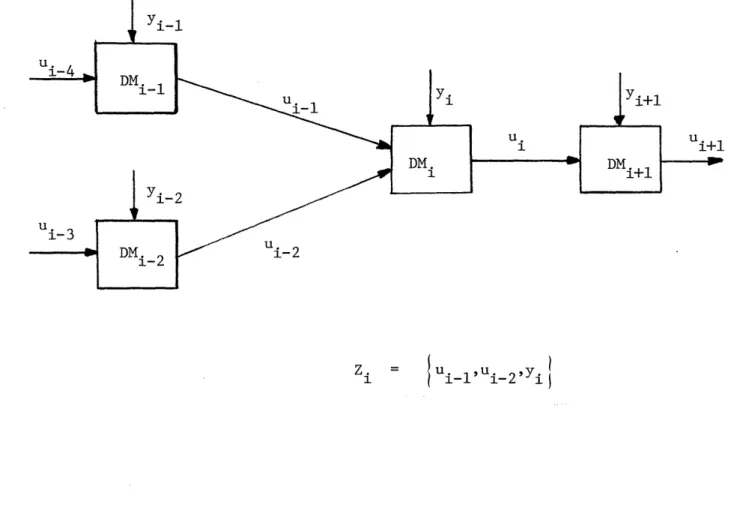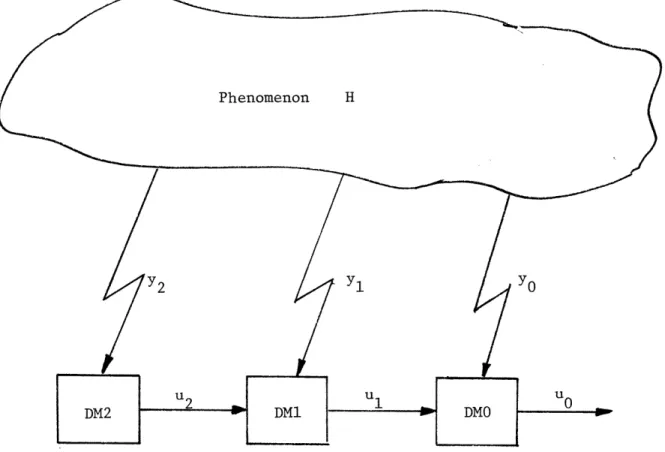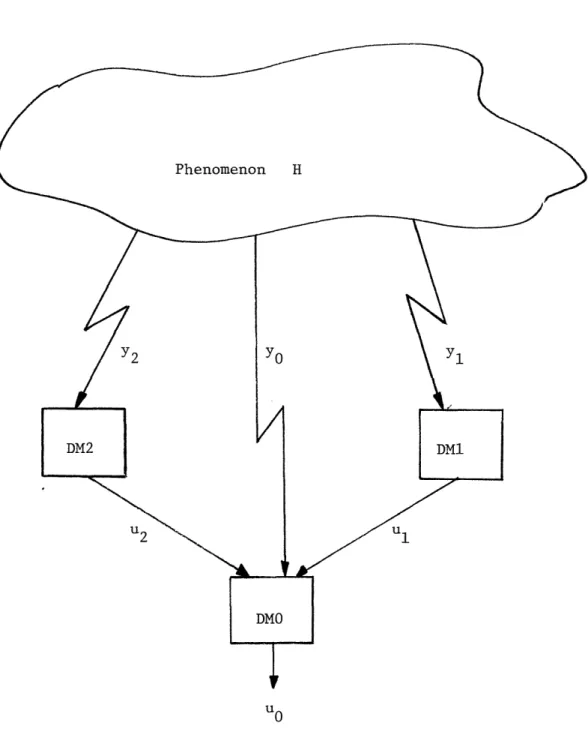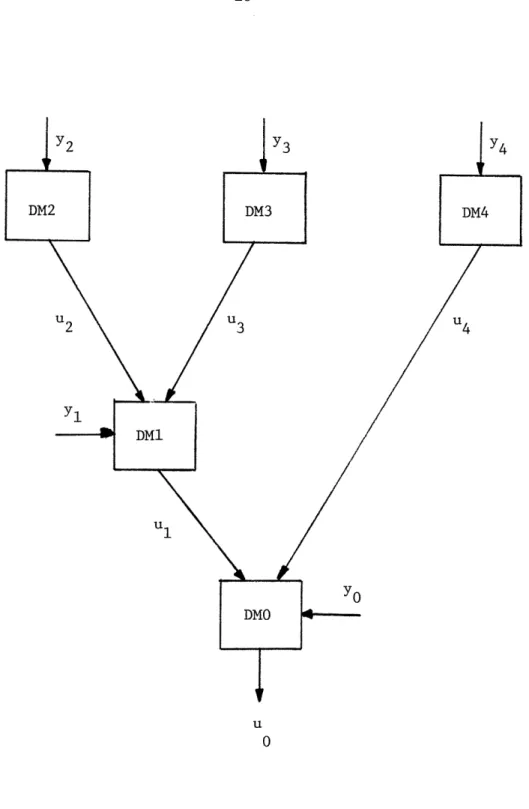Detection Networks
L.K.Ekchian and R.R.Tenney2
Abstract
Each member of a team of decision agents receives a conditionally independent observation about some underlying discrete hypothesis. Subject
to causality constraints, the agents seek to optimize a team cost functional by making discrete decisions which are conveyed to other agents on capacity constrained channels. This paper derives optimal decision rules for a
class of problems of this type and discusses their properties.
l.This research was supported by ONR contract N0014-77-C-0532 (NR-041-519)
2.Both authors are with the Laboratory for Information and Decision Systems, M.I.T., Cambridge, Ma. 02139. Address all inquiries to Dr. Tenney,
I.Introduction
Purpose: Team theory has long sought to unify the joint estimation/
communication/ control problems that arise when several agents that receive different information attempt to cooperate [2]. These problems have
proven to be rather difficult in many cases [11], although a suprising number of them can be reduced to an equivalent static framework [3,4]
through reformulation.
Building on [8], this paper describes the solution of
a number of specific team problems with non-partially nested (non-NP) information structures. The problem is made tractable by assuming that the underlying natural randomness takes the form of a fixed, discrete
hypothesis and that the decision agents receive conditionally independent observations. This permits explicit computation of decision rules,
even when communication (preassigned flow pattern) is allowed between agents. The decision rules themselves display an interesting structure which aids interpretation of the solution (e.g. in terms of an optimal
quantization of the local information). The insight gained from this work will serve as a stepping-stone for the development of a general
solution procedure for distributed hypothesis testing with communication constraints.
Related Work: As the logical sequel to [8], Sections 2 and 3 present results for two special classes of structures: tandem and hierarchical. The
problems discussed are endowed with digital communication links between the decision-makers (DMs). A predetermined causal precedence ordering is imposed as each DM needs the decisions of his predecessors before it can generate its own decision. We retain however, the assumption that the actions of the DMs do not in any way affect any system dynamics.
However-, unlike problems with predetermined communication variables (e.g. one-step delay information sharing [7], [5] and [10), the communicated variables are limited to m discrete values with their content to be
determined. Messages are conveyed error free, i.e. we do not consider noisy channels [1], although generalizations to this case can readily be drawn. While the m discrete value channels provide encoding capability, we are not interested in coding per se [1] but rather seek the overall
optimal communication and decision strategy. Note that this allows explicit signalling [9] from a DM to "downstream" DMs through the communication links.
Problem Statement: Find Xi :Zf ii)i ' {0,1, .-.. ,N}, to minimize
J(Y,,... Y. ) = E J(uo,H)} where u is the output of the detection network; {u,u,...,uN are internal communication variables; and Zi is
the information available to DMi as specified by its access to: (1) a local observation yi and (2) other decisions specified by the topology of the communication network (Figure 1). Finally H is the underlying discrete state of nature.
Overview of results: Solutions are available for binary problems where HCfH°,Hlj and Ui{O,lj, and a number of network topologies. Extensions to
ui-4
v DMi{ 1 Yi Yi DM D DM. Yi-2 DM 3 Di-2 i-2 Zi = T Ui-l'Ui-2'Yi IM-ary hypotheses and mi symbol channels are straightforward and discussed in Sections 2 and 3.
II.Tandem Team Configuration
Assumptions: The tandem network topology is illustrated in Figure 2. H° and H1 arise with known a priori probabilities
P(Ho) = PO P(H ) = 1 (1)
The joint conditional observation distribution is
P(y0,Yl/Hj ) for jEtO,11 (2)
where the subscripts denote the DM. (The yi s may be random vectors generated by "preprocessing" of the original measurements). The global cost function is defined by J(uo,H) where
J : |0,1} X AH ,H } r NR (3)
The objective of the team is to minimize
E {J(uO,H) (4)
and we will interpret
0O~ H0 is declared
u (5)
o 1
H is declared
Phenomenon H
y 1 y
0
U1 0
DM1 DMO
decision rules:
Assumption 1: The observations yo and y1 are statistically independent, i.e.
p(yl/oy,H) = p(y1/H) (6)
p(yo/Yl,H) = p(yo/H)
(See [6] for a case of dependent measurements without communication). Assumption 2:
(a) J(1,H°) > J(O,H°) (7)
as per the interpretation of J
(b) p(uo=O/ul=O,Yo) P(uo=/ul=lYo) (8)
this disambiguates two possible symmetric solutions
Derivation: We begin with Lemma 1:
J(u H°)[p(uo/ul = O yl) - P(Uo/u=l,y )]<0 (9)
0
Proof: Expanding expression (9)
J(O,H°)p(uo=O/ul=0,y0) + J(1,H°)p(uo=l/ul=O,yo)
-J(O,HO)p(uo=O/ul=l,yo) - J(1,HO)p(uo=l/ul=l,yo) (10)
But
P(Uo=l/ul=O,y o) = 1 - p(uo=/ul= 0 (1Yo) p(uo=l/ul=l,y) o = 1 - p(uo=O/ul=l, o)
Substituting (11) into (10) and simplifying
and Assumption 2 gives expression (12) is less than 0. Q.E.D. This lemma is required for proving:
Theorem 1: The decision rule for DMO (Figure 2) is given by
UO = o
(O,
,u,)
(13)
and 'o(.) is the following likelihood ratio test:
ao;O
o ^
p(y 0
/H')
K
p(I')io)p(u,/F/)fj(o,,H).J
,
(,()
? (yPo/') < P(H°)p (u,/"/
,,
°)[ / H)--o o, )_U,=t ,
{{/': U,,=
t°
7/
U,:/
The decision rule for DM1 is:
u,:
,
(,)
(16)and
,(')
is the following likelihood ratio test:p(A
i,/')
<
E
P(H,7"o,,,,,/")[p(,o/I,,,-.
H"o)
-:,
,/u,,-o,//~
' t/
The objective
min E fJ(uo,H)3 (9)
is expanded explicitly as:
.£ u,,y~. , H) ,dyo d,
UuC~~o I YOXI/,(u
lu
o ,,yo H)p(u,,y.,
0/) 7.u,
4/)o
y, ,yo (20)>; f
p(.4o/,
)
sy,
114
,)p(y/))
7o(
uo
)
)
Jo
J,
(,)
Explicitly summing over u1 and ignoring constant term, the expression to be minimized reduces to
ZJP(uDO./u.
YO)IfP(/)/)(YJA11H)PYON//)bA(O
Ht)
-JL,
)dyO dy, (22) This expression is minimized by settingI~O
;/
ZP(H)pfu./b)pf(yo/hN)/J(o,.)
--
Jt,,)]>o
C
H(Ho
t
O!.
(.23)
0/ o/Ae ,-*;.se
Expanding over H and invoking Assumption 2(a) yields the decision rule for DMO given in expression (14).
For l(.) , write (21) as
o
f
P(),r(uo
/,
?(y,/,)
y¥
)
fpl/y
p(
,)
yo/#)
4?vi, ,
)
dyo
y
(24)ex, y,,y,
Explicitly summing over u1, substituting p(ul=l/y1) = 1 - P(ul=O/y1) and ignoring the constant term yields
0.,4)
/
olbe
/w;(seExpanding over H and invoking Lemma 1 yields the decision rule for
DM1 given in expression (17). Q.E.D.
Summary: The person-by-person optimal decision structure is based on three thresholds that must be calculated together:
t to = fo(l(
f
))/ u =0 (27)tl = fo('l(.))/Ul=l
where fl(.) and f0(.) are defined in expressions (14) and (17). The simultaneous solution of these equations yields the three thresholds. Extensions:
Theorem 2: For the tertiary hypothesis case, i.e. HE {H ,H , H2 and tertiary symbol channel capacity, i.e. u.if0,1,2J , itJ0,1}, the decision rules for DM0 (Figure 2) is given by
NO t o (YO) U)( 8)
and lO(') is the following set of likelihood ratio tests:
uo i ork
A'
po(Y/oh')
<
gi)pf(u,//l
[J(tJi/H)-f('
;/(H
j
]P(Hkij(,6,,/)XA',J(/j/)-,J(j,H)
MO j ork
9)
for (i,j,k)( (0,1,2),(0,2,1),(1,2,0)1
and '(') is given by the following set of likelihood ratio test:
M,,I
k
I,'Iuv//./').>
Pr/.9A,
uok/).:~.
_ _-?_,_
-_ ,/;,to)]
4~
,
LDO 3(Uou,:tff __(H_ HO_ ____ _ _ _ _ _;_p_(_,,
_ __(3/)
for (i,j,k)E {(0,1,2),(0,2,1),(1,2,0)}
Proof: Consider expression (20)
:E
P(x)?
.o
I.
,),,
y,)p
4
y,
IH)
p(yo/H)J(wo,
H)yo
dyl,
·, Yo,Y, ,(3 2)
Jlr(.
olIu,,Y)
w%7o,,)
o)P(/).p(u,
I)P(Yyo/)
,yo
Hence the decision rule is deterministic and is given by (29). To show (31) rewrite (32) as
E/'(Y
., lO F
and parallel the proof of Theorem 1. Q.E.D.
Theorem 3: For the Three Tandem DM case (Figure 3) and binary symbol capacity channels, the decision rule for DM0 is biven by
U.
= X.
(YOo
,4)
(34)
and Y'o(")is the following likelihood ratio test: A4'=O)
0 P(yo/-') < PI')/( 1,/HO/)[jI, qo) J(oH 0 7
o
0 /
a,
(36)
Phenomenon H
Y2 / YO
Y 2 Y 1 uO
Fu /3 he m Tply l
The decision rule for DM1 is
u, = / (y,, i) (37)
and Z (.) is the following likelihood ratio test:
.o(yt,,~
Ptuo pta,/.H).
W"
7u,,#)f?(o
(uo/,,-,,
l,:o,:)-F
0
])7
'"
,
'";
AThe decision rule for DM2 is
and t2(T) is the following likelihood ratio test:
Proof: Invoking similar steps as in Theorem 1. Q.E.D.
Extensions to M-ary hypothesis, mi symbol channels and N-tandem DMs are straightforward.
III.Tree Team Configuration
Assumption: Consider same assumptions as in Section II. First consider the simplest tree topology (Data Fusion) illustrated in Figure 4. Theorem
4:
The decision rule for DMO is given byo
A
q1
~Yo/NO)
>
t,)p, /h),/,)[J
')-,,
')
(4,)
A°
''o/'
/H,')
/' c<?P(o)pe,
/f
°
)O)p(z / 9o)/j,,iHo) -J(oo
)7
to if u1=0, u2=0 01 b to A to1 if ul=O, u2=1 (2) 10 to if ul=l, u2=0 11 to if ul=l, u2=1
The decision rule for DMi (i4f1,2}) is
Phenomenon H
DMO
UO
Figure 4: Optimal Data Fusion Topology0
and i(,) is the following likelihood ratio test: 4; = 0
~
P(
y
3//M
/
0) ____>_________________________________4.AO, = , _
_: t
(4a)
Proof: This proof parallels the one in Theorem 1. Q.E.D.
Extensions: Consider DM1 in the tree structure illustrate in Figure 5. Assume the pair of decision rules in DM4 and DMO are fixed. Then a cost function of u1 and H at DM1, J(ul,H), can be obtained by taking the expectation over y and y4, i.e.
U,
)i
-
;vuo,) |
TN(-
),x(o)
YoI YIe
Given this cost, one can solve for decision rules fl',,7 and
Vs
using Theorem 4. Inserting these decision rules into the the DMs, one can compute p(ul/H). Then one can solve for the decision rules for DMO and DM4 with u1 (described by p(ul/H)) by using the results from the tandem case (Theorem 1). Note that u1 acts as an additional measurement to DMO. The result of this process is an iterative procedure for alternately computing ,6qIo, and 64' i, which exploits a decomposition')"'resulting from the independence of observations when conditioned on
H (Assumption 1). This suggests a procedure for extending the results for these simple cases to larger networks.
Y2
Y3
Y4
DM2 DM3 DM4 U2 U3 U4 Y1l DM1 U1 DMO u 0IV.Summary
Optimal decision rules for a static non-PN detection team have been derived. The decision rules are likelihood ratios in the actual data, with thresholds determined by incoming communicated messages, The number of thresholds at each DM is equal to the number of combinations of these discreteinputs. Moreover, it is apparent that, at least for some tree structured problems, a decomposition principle (along the lines of spatial dynamic programming) can be found for methodically --computing decision rules. This is a topic of current research and will be reported in a subsequent paper.
References:
[1] Gallager, R. G., Information Theory and Reliable Communication, Wiley and Sons, Inc., New York, 1968.
[2] Ho, Y. C., "Team Decision Theory and Information Structures," Proceedings of the IEEE, Vol. 68, No. 6, June 1980, pp. 644-654.
[3] Ho, Y. C. and T. S. Chang, "Another Look at the Nonclassical Information Structure Problems," IEEE Trans. on Auto. Control, June 1980, pp. 537-540. [4] Ho, Y. C. and K. C. Chu, "Team Decision Theory and Information Structures
in Optimal Control Problems - Part I," IEEE Trans. on Auto. Control, Vol. AC-17, No. 1, February 1972, pp. 15-22.
[5] Kuratran, B., "Dynamic Two Person Two Objective Control Problems with Delayed Sharing Information Pattern," IEEE Trans. on Auto. Control, Vol. AC-22, August 1972, pp. 659-661.
[6] Lauer, G. and N. R. Sandell, Jr., "Distributed Detection of Known Signals in Correlated Noise," ALPHATECH Report (in preparation), Burlington, MA, March 1982.
[7] Sandell, Jr., N. R. and M. Athans, "Solution of Some Nonclassical LQG Stochastic Decision Problems," IEEE Trans. on Auto. Control, Vol. AC-19, April 1974, pp. 108-116.
[8] Tenney, R. R. and N. R. Sandell,Jr., "Detection With Distributed Sensors," IEEE Trans. on Aerospace and Electronic Systems, Vol. AES-17, No. 4,
July 1981, pp. 501-510.
[9] Thompson, G. L., "Signalling Strategies in n-Person Games," Contributions to the Theory of Games II, Princeton, pp. 267-276.
[10]J Varaiya, P. and J. Walrand, "On Delayed Sharing Patterns," IEEE Trans. on Auto. Control, Vol. 23, June 1978, pp. 388-394.
[11] Witsenhausen, H. S., "A Counterexample in Stochastic Optimum Control," SIAM, Vol. 6, No. 1, 1968, pp. 138-147.




